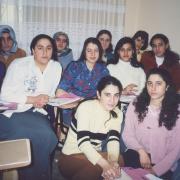Tactic case studies provide first-person, detailed information on the use of a tactic and how it may be adapted to other situations.
The authors -- from diverse walks of life and human rights issue areas -- recount their personal experiences in these detailed tactical notebooks. Although their backgrounds and situations differ, all used innovative tactics to help address an urgent human rights situation. Read these case studies to learn how a tactic was actually implemented, what factors influenced its use, and the challenges that surfaced along the way. We hope these examples of how tactics were used in sometimes dangerous, real-life situations will help you think tactically, to consider adapting these tactics to your own context, and adding these tactics to your own tactical repertoire.


 Women for Women’s Human Rights (WWHR)-New Ways in Turkey gained the support and use of government resources for furthering human rights education of women at the local level. WWHR-New Ways developed a highly successful human rights education curriculum for women. They developed a partnership with government run, local level community centers, these community centers offered not only professional social workers who could be trained by WWHR-New Ways in facilitating the human rights education curriculum, but also a safe and accessible place for women to learn about their rights.
Women for Women’s Human Rights (WWHR)-New Ways in Turkey gained the support and use of government resources for furthering human rights education of women at the local level. WWHR-New Ways developed a highly successful human rights education curriculum for women. They developed a partnership with government run, local level community centers, these community centers offered not only professional social workers who could be trained by WWHR-New Ways in facilitating the human rights education curriculum, but also a safe and accessible place for women to learn about their rights.  The Advocactes for Human Rights (formerly known as the Minnesota Advocates for Human Rights) uses traditional human rights monitoring methods to document human rights abuses. The group has also made a practice of adapting this methodology to emerging human rights issues. Minnesota Advocates has identified and developed practical and sustainable strategies for adapting human rights monitoring methods to address domestic violence (in Eastern Europe and the U.S.), child survival (in Mexico, Uganda and the U.S.) and transitional justice (in Peru).
The Advocactes for Human Rights (formerly known as the Minnesota Advocates for Human Rights) uses traditional human rights monitoring methods to document human rights abuses. The group has also made a practice of adapting this methodology to emerging human rights issues. Minnesota Advocates has identified and developed practical and sustainable strategies for adapting human rights monitoring methods to address domestic violence (in Eastern Europe and the U.S.), child survival (in Mexico, Uganda and the U.S.) and transitional justice (in Peru). Human rights activists as well as the museum community can make effective use of the spatial impact of historic sites to help educate people about social change and human rights. The Tenement Museum in New York City has joined with more than a dozen other institutions that have focused their attention on “sites of conscience”—places where terrible human rights abuse has occurred that should never be forgotten. Their goal is not only to remember the past, but also to use the emotional power of these places to catalyze critical thinking about the ongoing social issues of today, through dialogue and educational activities.
Human rights activists as well as the museum community can make effective use of the spatial impact of historic sites to help educate people about social change and human rights. The Tenement Museum in New York City has joined with more than a dozen other institutions that have focused their attention on “sites of conscience”—places where terrible human rights abuse has occurred that should never be forgotten. Their goal is not only to remember the past, but also to use the emotional power of these places to catalyze critical thinking about the ongoing social issues of today, through dialogue and educational activities. When the Canadian government refused to make public draft documents in their negotiations over the Free Trade Agreement of the Americas, Operation SalAMI organized hundreds of citizens to show up holding “Search and Rescue Warrants” for the release of these draft documents. The government responded by arresting one hundred citizens for requesting their right to information.
When the Canadian government refused to make public draft documents in their negotiations over the Free Trade Agreement of the Americas, Operation SalAMI organized hundreds of citizens to show up holding “Search and Rescue Warrants” for the release of these draft documents. The government responded by arresting one hundred citizens for requesting their right to information.